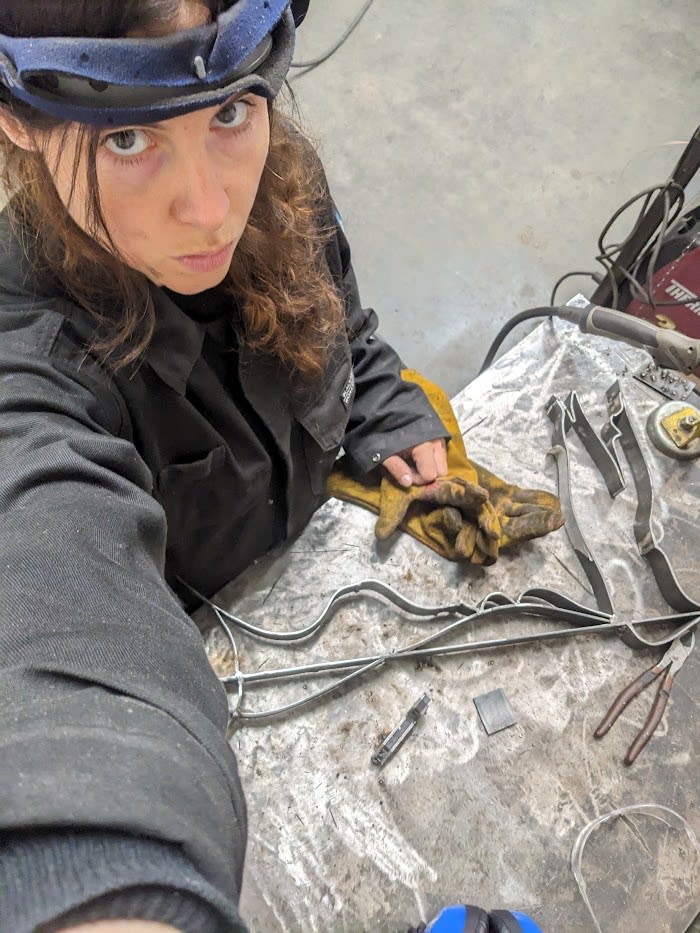-
KALI Gallery: Your work often balances sincerity and artifice. What kind of emotional tension are you exploring in that space?
Héloïse Chassepot: It is only sincerity coming from me. Then if there is truth, I don’t know, it’s another question, I guess. Although it is often a situation of an ironical paradox that gets me started on a certain motif, once I’m there it all gets rooted in me very sincerely. If there wasn’t sincerity, I wouldn’t be able to spend much time on a work: jokes never last long. Then, yes the way I paint, my use of colors, the gestures, all might look something like artificial, or at least something like the expression of a strong assertive subjectivity. I’d say it is because I am importantly interested in the cultural structure that underlies the emergence of an image; so my references are never “natural” (if even it exists), they rather belong and acknowledge their own cultural context of existence.
-
KG: Has being in London shifted your sense of intimacy or vulnerability in your work?
HC: It has definitely shrunk the size of my studio and therefore the physical relation to my work: most of the time I paint seating on the floor a few centimeters away from the painting (laughs). More seriously, the precarity in which a majority of the artists (and a majority of the population) lives in London had for consequences to radicalize my relation to my practice: I feel a sense of urgency.
Actually, that is partly a feeling that I intended to translate in the new series of paintings and the sculpture that I’m showing in “Positive Paradox”. Crossing the bridges of London - which you often have to do to reach parts of the city, propels a picturesque experience. It means that the landscape “naturally” gives itself under a harmonious compositional sense, like a perfect picture. A bridge has this unique ability to put oneself at a distance allowing the view to appear under its best self, postcards-like. Similarly, the distance that allows the view to appear engenders a feeling of exclusion: you never belong to the view; you’re the spectator as much as the outsider of the view. And I think there is a strong correlation between this phenomenon and what happens when I make art.
-

KG: In Becoming an Apple, you blend absurdity and transformation. Are you escaping the self, or expanding it?
HC: There is indeed a sense of performance in every medium I approach. Whatever I make, I think of how it can be read within a wider narrative. this isn’t necessarily to anticipate an audience’s reception, but it is merely because may of the works project themselves in a larger cosmology of fantasies that attempt to reflect on the societal role of an artist. So, for instance, while painting my tree-year series of flowers, I was very attached to the idea of becoming a flower painter. Painting London skylines, I wish becoming a landscape painter. There is a certain absurdity and sometimes deceitfulness that comes with the renewal of my own status but somehow, it's this larger scale that provokes symptoms of derealization by witnessing one's own actions that allows my practice to be anchored in a social and political reality. It's the only way for me to engage with art.
-
KG: You mention being a painter of flowers, being a landscape painter: they are very popular genres encountered in amateur’s practices: what is your relation to amateurism, do you consider yourself as an amateur?
HC: I hold the amateur as a dreamed archetypal figure of resistance in a context of hyper-professionalization and hyper-capitalization of time of an artist’s existence. I’m also aware of the potential controversy and contradiction it can propel when advocating in favor of amateurs but that’s also why it makes this figure so interesting, it bears so many ambiguities. There are great notes on the amateur from Roland Barthes which shaped my own imagination on amateurism. I also definitely fetishy a great withdrawal as accomplished by Lee Lozano, Charlotte Posenenske, Adrian Pipper (and it appears even more meaningful when coming from women in the current state of the art world).
-
KG: Your materials often feel deliberately awkward or unrefined. How do you think about imperfection in your process?
HC: I often use crafty technics (nuno felting, papier mâché, salt dough modelling) that I get to understand thanks to Youtube and its incredible community of free workers that make tutorials. While my body incorporates certain gestures quite naturally, like with painting, I tend to break the smoothness with crappier materials, random gestures ad unstable knowledge. Charline van Heyle and her Hakenschlagen strategy has helped me keeping doors open for things to happen at anytime.
-
KG: Repetition is key in your work. Is it meditative, critical, or both?
HC: Both, indeed. I think the power of a (digital) image is nowadays evaluated in regard to its capacity to be repeated and eventually to become viral. Along this process, repetition creates sameness and eludes the notion of original. Working with a serial motif, I intend to silence the motif, to cancel it out. One flower, you look, two flowers, you compare, ten flowers, they’re just flowers: the more they are, the more it gets abstracted, and the individual relation fades away. So, in a way, repetition is an anti-communicative strategy that regretfully is used most of the time to infuse certain ideologies, and that I use to re-create a certain pudeur around the work.
KG: Your titles are playful, ambiguous, and emotional. Where do they come from—instinct or construction?
HC: I’m fond of literal titles. Giving titles is a pretty recent habit in the history of art; I’m particularly attracted to the late18th, early 19th century titles, when artists started depicting mondain motifs and used descriptive titles for them (The train in the snow, Monet). I find it funny to enclose a work of art that exerts a lot of subtle feelings in such prosaic description: it creates tautological situations, and it completely eludes the sacred aura attached to an artwork. Visually my work borrows a lot from abstract language, so I like to quite directly name what they are and cut through the mystery. If ever there is mystery in my title, it is to take the piss.
In Conversation with Héloïse Chassepot
Current viewing_room
Héloïse Chassepot’s work moves deftly between sincerity and artifice, drawing on familiar visual languages—flowers, ribbons, softness—to question cultural assumptions and explore emotional nuance. In her upcoming duo exhibition Positive Paradox with Swetlana Heger, she merges painterly and sculptural elements to reflect on the role of the artist within the social and spatial realities of London. In this interview, Chassepot speaks about her attraction to amateurism, the tension of repetition, and why irony can only emerge from a place of deep sincerity. What appears playful or decorative on the surface often conceals a complex negotiation with identity, perception, and artistic autonomy.






